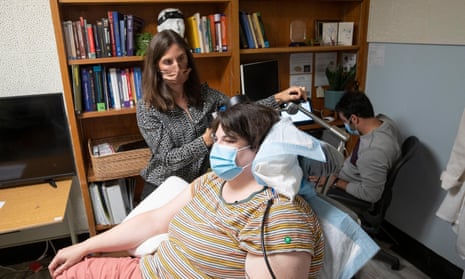A woman with severe depression has been successfully treated with an experimental brain implant in a “stunning” advance that offers hope to those with intractable mental illness.
The device works by detecting patterns of brain activity linked to depression and automatically interrupting them using tiny pulses of electrical stimulation delivered deep inside the brain.
The 36-year-old patient, Sarah, said the therapy had returned her to “a life worth living”, allowing her to laugh spontaneously for the first time in five years.
Although the therapy has been tested in only one patient – and would only ever be suitable for those with severe illness – the success is seen as hugely significant. It is the first demonstration that the brain activity underlying the symptoms of mental illness can be reliably detected and reveals that these brain circuits can be nudged back into a healthy state, even in a patient who has been unwell for years.
“We haven’t been able to do this kind of personalised therapy previously in psychiatry,” said Katherine Scangos, an assistant professor of clinical psychiatry at the University of California, San Francisco (UCSF), who led the work. “This success in itself is an incredible advancement in our knowledge of the brain function that underlies mental illness.”
Prof Rupert McShane, a consultant psychiatrist and associate professor at Oxford University, who was not involved in the trial, said: “This is a stunning demonstration … which points to a way of examining the biology of the abrupt slumps into despair that can be so destructive.”
Between 10% and 30% of people with depression do not respond to at least two drug treatments – equivalent to about 2.7 million people in the UK.
During the past two decades, deep brain stimulation (DBS) has been used to treat tens of thousands of patients with Parkinson’s disease and epilepsy. However, several trials for depression have ended in disappointment. A major challenge is that the brain does not appear to have a single “depression area”; several interconnected areas can be in play and these can differ between people.
“We’re starting to recognise some of the complexity involved in how mood is regulated in the brain as a network,” said Prof Edward Chang of the University of California San Francisco, the neurosurgeon who treated Sarah.
A meticulous, personalised approach paved the way for the latest advance. In an initial phase lasting a week, a temporary brain implant recorded a wide range of activity while Sarah regularly logged her mood on a tablet. A machine learning algorithm was used to identify a telltale pattern of activity in the amygdala region accompanying Sarah’s lowest points.
Through trial and error the scientists identified a closely connected brain area, the ventral striatum, where a tiny dose of electricity appeared to have an immediate and profound impact.
“When I first received stimulation I felt the most intensely joyous sensation and my depression was a distant nightmare for a moment,” said Sarah. “I just laughed out loud. It’s the first time I had spontaneously laughed or smiled … in five years.”
In a second round of minimally invasive surgery, a permanent device was implanted, with a tiny battery unit embedded in her skull, to detect the “depression signature” activity in the amygdala and automatically deliver stimulation to the ventral striatum.
This happens about 300 times each day, equivalent to about 30 minutes of stimulation. The electrical pulse is not accompanied by any sensation, Sarah said, aside from a subtle feeling of alertness and positivity.
“The idea that we can treat symptoms in the moment, as they arise, is a whole new way of addressing the most difficult-to-treat cases of depression,” said Scangos. She hopes the work will also help dissolve the stigma that “comes from the black box nature” of depression.
Sarah described a life before the treatment in which she barely moved, no longer had opinions and “only noticed what was ugly in the world”. After five years of suffering, she had run out of treatment options. The profound effect of the implant confirmed to her that her depression was rooted in brain biology and “not a moral failing, but a disorder that could be treated”.
The device costs about $35,000 (£26,000) and is an adapted version of one normally used to treat epilepsy, called the NeuroPace RNS System. The UCSF team has already enrolled two more patients and hopes to recruit a further nine to assess whether the technique can be more widely applied.
Prof Eileen Joyce, a professor of neuropsychiatry at University College London, who is leading a trial using deep brain stimulation for OCD, said: “The results are genuine and significant. It’s a remarkable piece of translational clinical neuroscience. I’m not sure that anyone else in the world is doing that at the moment but I’m sure they will in future.”
McShane said that while the method would not be widely or immediately applied, “if I was a medical student thinking about which field will show exciting developments during my working life, I would be clocking this as a reason to be considering psychiatry”. The findings are published in the journal Nature Medicine.
